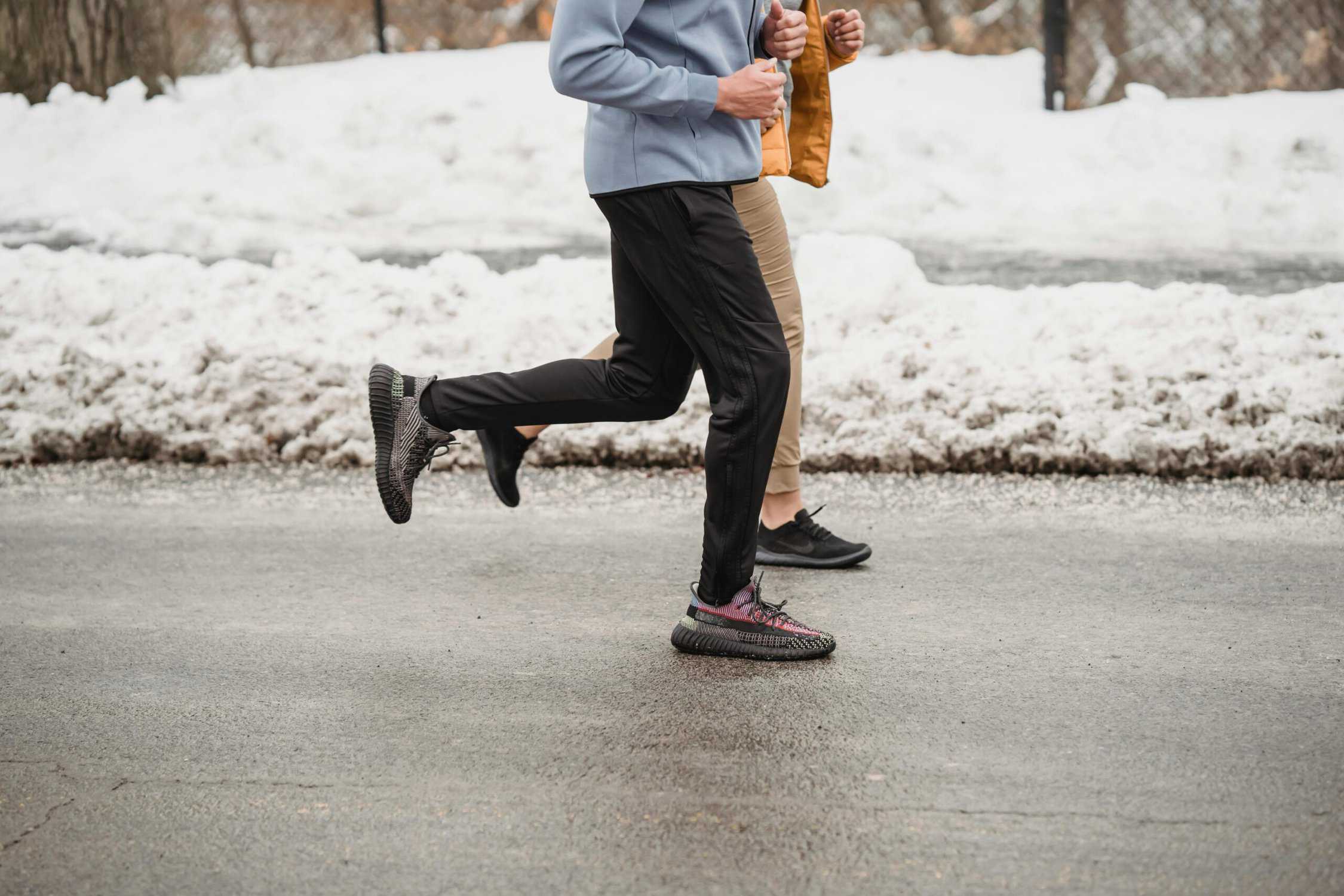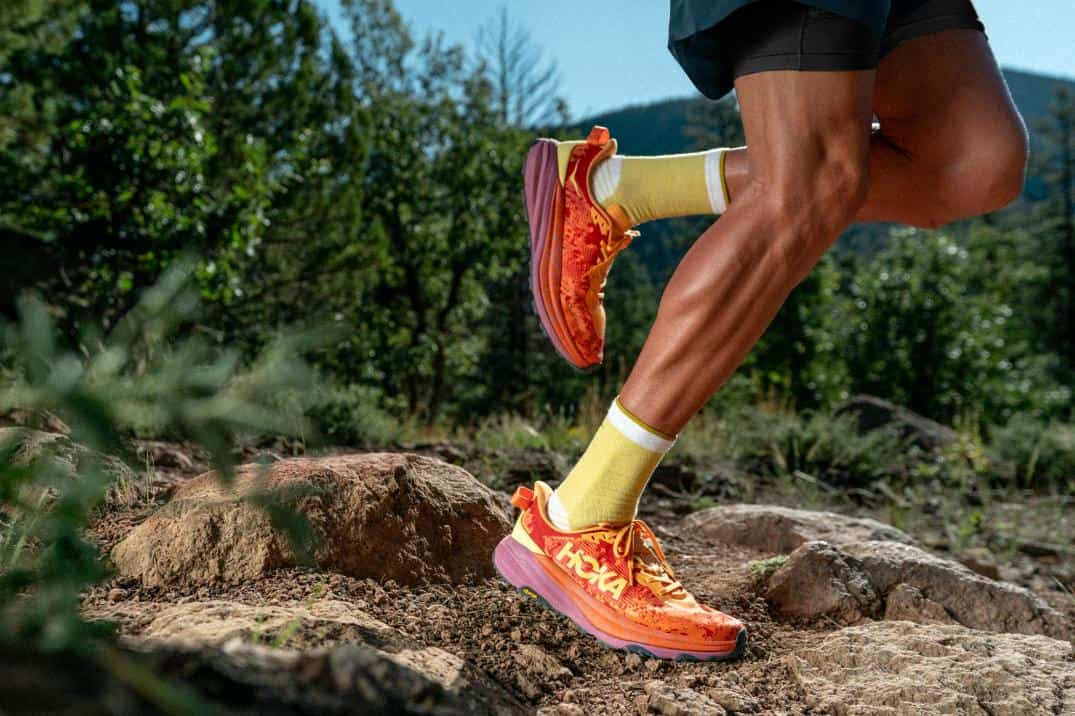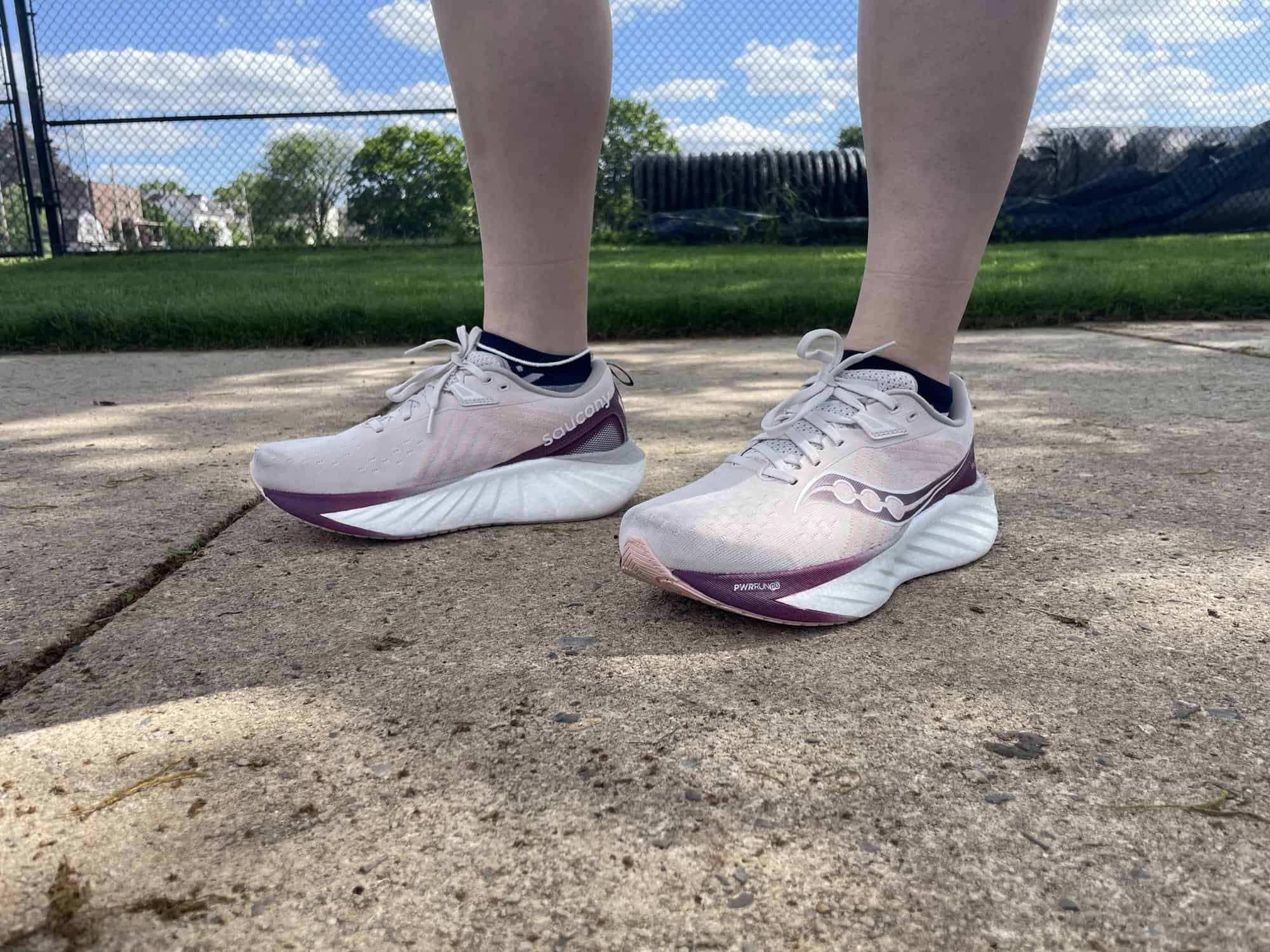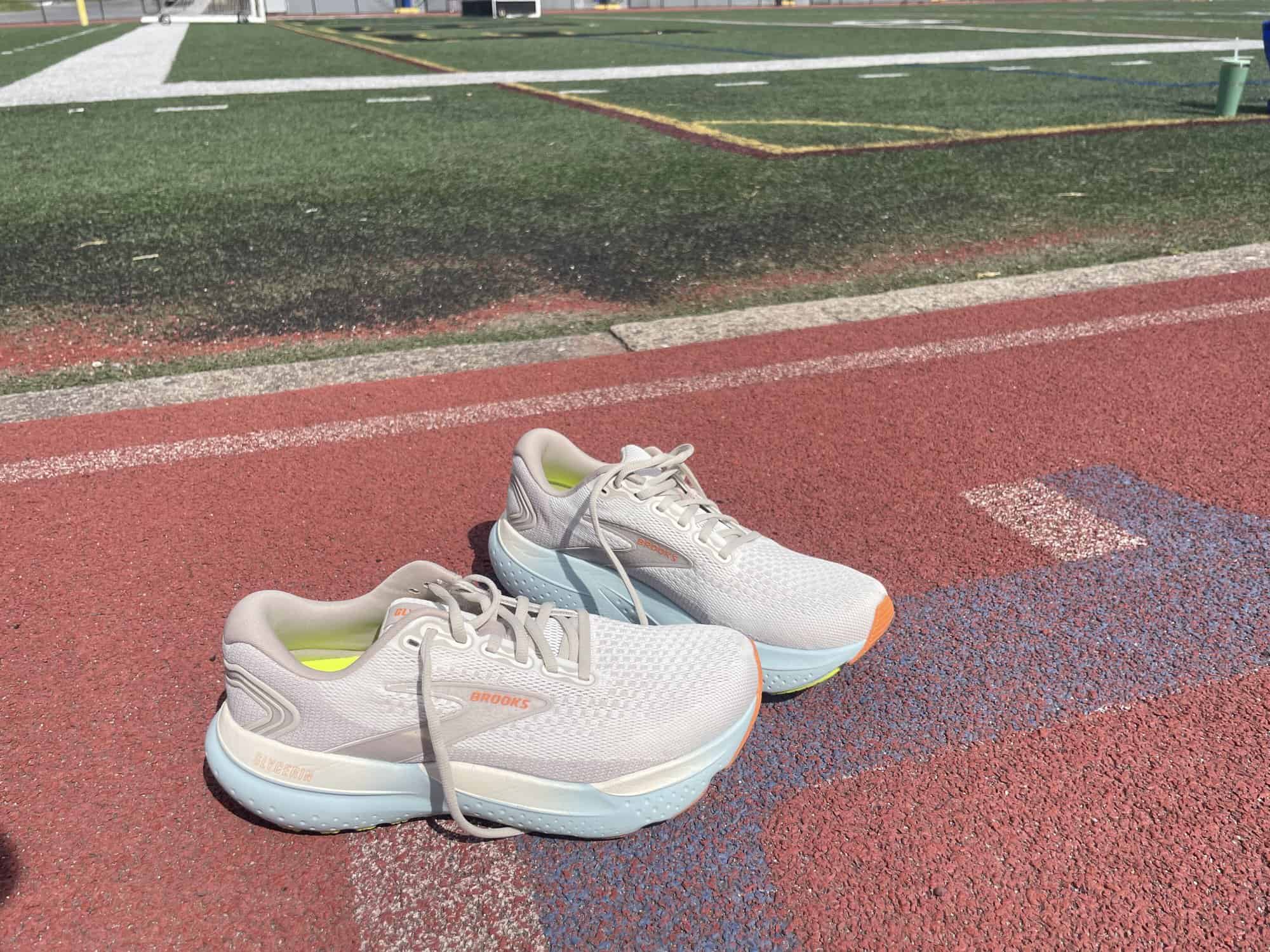Hoka and Brooks are two of the biggest and most popular running brands in America—and for good reason: Both have an excellent selection with models ranging in design, stability, cushioning, weight, and drop, and are well known for making quality products known for their support and comfort.
But, there’s a number of meaningful differences between the types of shoes that each brand produces. These may mean in Hoka vs Brooks, there’s one better fit for you.
As a runner and gear writer, I have personally run in a range of models from both brands since 2015. I have also worked in running retail for over 7 years and I have first-hand experience both fitting and talking real runners through the pros and cons of different shoes from both brands.
There are certainly a ton of great running shoes from many other brands out there. But when it comes to half marathon running shoes, Hoka and Brooks are two of the leaders.
“When an athlete I work with asks me for shoe recommendations, I usually have three shoes that I guide people to at least try: the Brooks Ghost, Brooks Adrenaline, and my favorite, the Hoka Clifton,” says accomplished distance runner and USATF-certified coach William Baldwin. “When talking to other running coaches, they almost always agree with those picks.”
Dr. Suzanne Fuchs, DPM, board-certified podiatrist and foot and ankle surgery specialist, adds that when it comes down to which shoe will serve you better, it comes down to personal preference and the specific needs of the runner. “Some runners swear by the cushioning and lightness of Hoka for long runs, while others prefer the durability and support of Brooks,” she says.
If you are trying to decide which may be a better fit, or you just want to familiarize yourself with the brand history, tech, and design, keep reading to learn more about what each brand has to offer.
Hoka vs Brooks: Key Differences
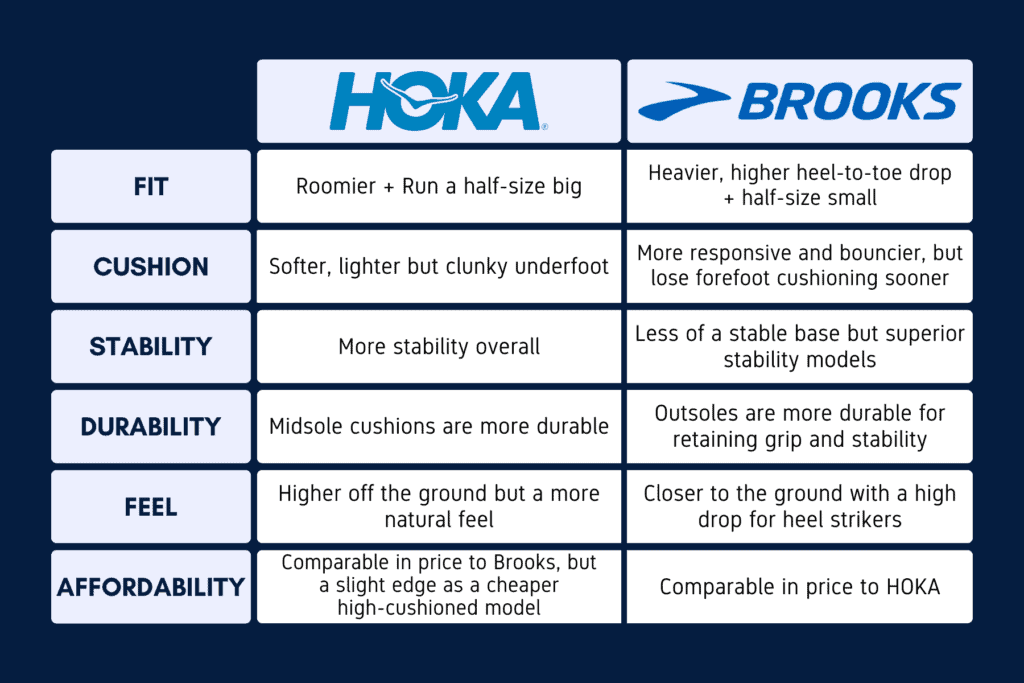
Hoka running shoes are known for:
- High cushion for comfort and shock absorption
- Meta Rocker for a smooth roll-through on every step
- Lower drop at 4-5 mm
- Wide midsole for a stable feel
- Lightweight design
Brooks running shoes are known for:
- Fitting comfortably on most feet
- Coming in a range of options, from light and snappy to plush and cushioned
- Having a grippy and durable outsole that’s great for all surfaces
- Offering adaptable support which works for a range of arches
- Being a similar shoe designs in both stability and neutral versions
Related: Our Favorite Cushioned Running Shoes We Tested
Fit
Fit will vary a bit between shoe models. There also seems to be a misconception that Hokas run narrow in the toe box and Brooks run wide. I tend to disagree.
For both of these brands, I’ve found that the toe box width can really vary between models, so assigning a label to either is a bit presumptuous.
Ultimately, if you have a wide foot, you probably want to opt for a wide width with both of these brands. This will ensure you have enough room to spread comfortably, and prevent hot spots, cramping, and blisters.
That being said, there are a couple of things that are pretty consistent across each brand.
Hoka running shoes fit a bit on the looser side, particularly if you have a narrow foot. But that’s not to say that they are particularly wide in the toe box. Rather they have more vertical space which is great for runners with high arches or higher volume feet.
Dr. Fuchs mentions that some of her clients experienced the toe box as being on the narrow side, but this really does vary with model.
Hokas are well-known for being a bit loose in the heel. This is especially in models like the Bondi which run wider and sit lower on the heel.
Hokas can also run a bit long; I‘ve found both myself and the majority of runners wear a half-size smaller in Hokas than my usual running shoe size.
Brooks, on the other hand, are known to run a bit small. It’s best to go up a half to full size from your normal street size to ensure that you’ll have enough length. That said, the feel of Brooks is often described as supportive and slipper-like.
The company has really aced the foot-feel department. This is thanks to a tapered midfoot, supported heel, and raised arch in the sock liner.
“[Brooks] offers a wide range of models that cater to the needs of different types of runners—no matter if you are a pronator, neutral runner, or supinator, there is an option that will work for you,” says Dr. Fuchs. Coach Baldwin also notes that the heel collars are plush and soft against the back of the shoe.
One of the biggest issues Dr. Fuchs found: Some runners find Brooks shoes to be a bit heavy, especially when it comes to speedwork or racing.
Coach Baldwin also adds, “One con for me when it comes to Brooks is that most of their shoes are made on a very high heel-to-toe drop.” For example, the incredibly popular Brooks Ghost has 12mm more cushioning in the heel compared to the toes. “This leads to a slightly less-natural feel, but it can be a good option if someone is battling Achilles or calf problems,” Coach Baldwin adds.
Related: The Best Running Shoes We Tried for Knee Pain
In short
- Hokas are typically more roomy in the heel and the toe box (but don’t necessarily run wide), and run a half-size big.
- Brooks run a half-size small but generally fit like a slipper, while perhaps being a bit heavier and often having a high heel-to-toe drop.
Cushioning
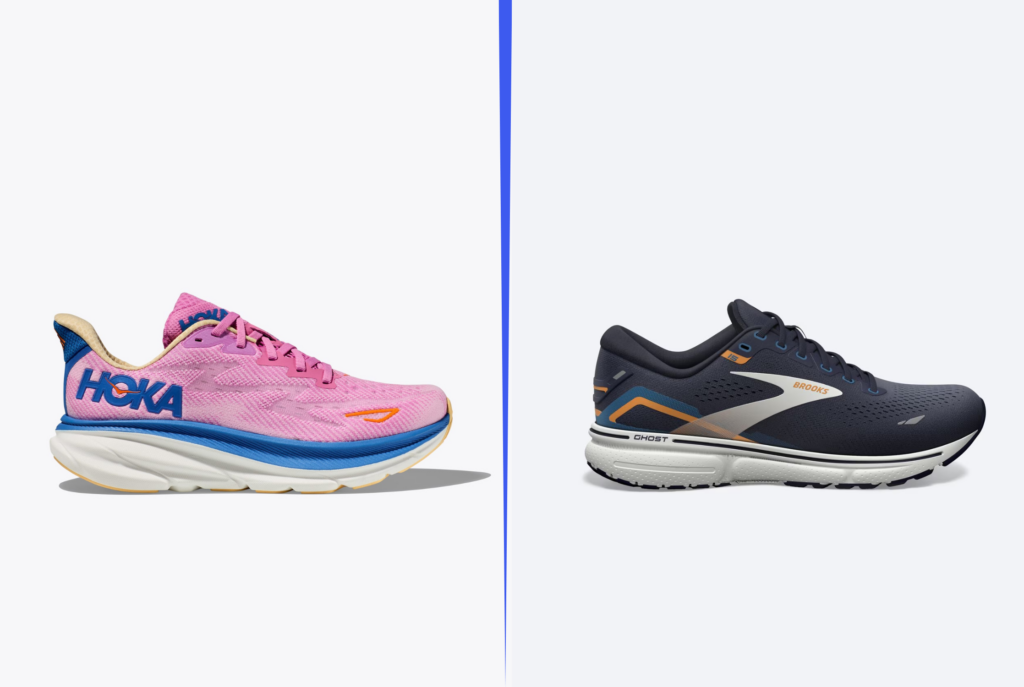
Coach Baldwin notes that the running world has been in an era of plush comfort and cushioning for the last few years. He also adds that Brooks and Hoka are leaders in running shoes with excellent cushioning. “This is a complicated formula because, as you put more foam and cushion into a running shoe, it typically gets larger, bulkier, and slower feeling,” he explains. “To combat this, they have created lighter, softer foams.”
While Brooks and Hoka are both best known for top cushioning, offers this in very different ways.
Hoka mainly uses EVA-based foams. Some models use a few different types and densities. But they all have the same base which is known for being light and plush.
Hoka has three levels of cushioning: light, medium, and max. But most of their shoes are still higher cushion than competitors in the same category. For example, the Hoka Clifton (mid-cushion) is more on par with the Brooks Ghost Max or Brooks Glycerin (both high cushion) than it is with the Brooks Ghost (mid cushion).
Because of their overall higher cushion, most Hokas do have a higher stack height than Brooks. This can require some getting used to. But Hoka employs its signature meta-rocker design to help roll through your foot, propelling you forward, rather than feeling like you are just clomping along.
“Most Hokas are also built on a rocker platform, meaning there’s a specific curvature to the bottom of the shoe which also helps add to that natural ride when one runs in a Hoka,” Coach Baldwin explains.
Dr. Fuchs points out that Hoka’s shoes are excellent at reducing impact on the joints and, despite their chunky appearance, they are also surprisingly light. This is a great option for runners looking for a cushioned-but-speedy shoe.
Coach Baldwin also mentions the impressive light weight of Hokas and their lower drop compared to Brooks. “This gives the oversized, cushioned shoes a more natural feel.”
Brooks, meanwhile, uses versions of their DNA foams—though most have all or at least some of the DNA Loft. The base of Brooks DNA Loft foam is still EVA, but it is injected with rubber and nitrogen which increases both durability and bounce.
This foam may feel a bit softer and bouncier underfoot than Hokas. It also tends to be a bit more responsive for runners that like some more energy return.
If you like a firmer, faster shoe, look for one with DNA Amp. This is on the stiffer side and used more in their lighter, speedier shoes.
In short
- Hokas are softer and lighter, and have excellent longevity, but they can feel a bit clunky underfoot
- Brooks are more responsive and have a bouncier feel, but they can lose their cushioned feeling quicker, especially in the forefoot
Stability
Both of these brands offer a range of stability and neutral shoes. But their stability is accomplished in different ways, so you may find that one fits your needs better than the others.
Hoka’s most popular stability shoes are the Arahi and the max-cushion Gaviota. These use a J-Frame system which employs a firm foam on the inner side and heel of the shoe to provide a higher-density surface where the foot would normally collapse; this, in turn, helps to prevent overpronation.
All Hokas—even the neutral ones; especially the Clifton and Bondi—will have more stability than your traditional running shoe. It uses a combination of a flare at the heel and toe box of the midsole. Together, these give a larger landing area. This gives you a more stable feel when on uneven surfaces. It also has the foot sitting about a quarter way into the midsole foam. This design allows the foam to hug the heel and support it on the sides, minimizing overpronation and excessive movement.
Overall, I’d argue Brooks shoes as a whole are less stable than Hokas—but that’s not to say that it doesn’t have excellent stability options.
Shoes like the Ghost, Hyperion, and Launch don’t offer much arch support, so they are best for neutral runners (or those that can get away with adding a light insole).
But its newest versions of the popular stability models, the Adrenaline GTS and Glycerin GTS, provide adaptable support.
This means that they can work for all kinds of runners—even the most neutral—because they will only provide the amount of support that you need. This system is accomplished through guide-rails which run along the sides of the foot and around the heel. This gives you support no matter which way your foot wanders.
In short
- Hoka offers more stability overall, even in its neutral models. But its stability shoes likely offer too much support for neutral runners
- Brooks neutral running shoes don’t have a very stable base, but its stability models work for any level of arch collapse from supinator to overpronator
Durability
Both Hoka and Brooks are pretty durable as far as running shoes go. But there are some elements of each shoe that will last better than others.
Hoka is known for their lightweight feel, and thick, plush midsoles that are made mostly from softer, EVA foam. This foam is not as durable as some of the midsole materials Brooks uses. But the sheer amount of it makes the shoe remain plush and comfortable for hundreds of miles, and can even increase the longevity of the shoe.
Depending on the model that you choose, some Hokas have more rubberized outsole than others.
But many have it strategically placed in the most high friction areas—generally the toe and heel. This works for most people, but some may find that their foot strike causes them to wear down part of the EVA that’s not protected by the outsole.
Again, since the midsole is so thick this won’t really affect the cushioning, but over time it can change the way the shoe hits the ground as well as grip.
One of Brooks key claims to fame is its durability. Dr. Fuchs notes that Brooks can withstand high-mileage training without losing cushioning and support. Having owned countless pairs of Brooks myself and worked in running retail for over seven years, Brooks does indeed seem to have the least amount of issues with breaking down—especially when cared for properly.
One of the most durable parts of Brooks shoes are the outsole. It does add a bit more weight, but the brand opts for a thicker, grippier outsole. This helps the shoe retain grip for longer and gives you necessary traction in wet, uneven, and slippery conditions. Brooks were always one of my top choices for the cross-country season as they performed just as well on road as on grass, gravel, and light trails.
The issueis that since there is less foam than in Hokas, you will start to get more ground feel a bit quicker. This more apparent in mid-cushion shoes like the Ghost. If you’re a heel striker, the foam will break down faster under the toe box or heel—sometimes before even the tread.
In short
- Hoka’s midsole cushions are more durable and, therefore, more ideal if you just run on a treadmill or road.
- Brooks’ outsoles last longer if retaining grip and traction are your top concerns on the longevity of a shoe.
Feel
Hoka and Brooks have quite different designs and, ultimately, different feels underfoot.
Most Hokas have a higher stack height and lower drop which means you won’t get much ground feel. But, thanks to its lightweight foam, you also won’t feel like you are wearing a pair of cinder blocks. Some runners find that the low drop and meta-rocker take time to get used to. But these features also help make a less-responsive foam feel smoother and speedier.
Dr. Fuchs did mention that, since many of the Hokas have thicker soles, the shoes will have little to no ground feel. Despite being light, some may feel there is too much underfoot. Coach Baldwin agreed, stating, “If I had to nitpick a con, I’d say that Hokas can be bulky, and there are times when a lighter, more streamlined shoe is better.”
Brooks will give you more of that traditional running shoe feel. That’s because its shoes sit closer to the ground with a higher heel and lower toe. Its shoes have an excellent fit with ample toe space and a snug arch. Plus you sit on top of the foam instead of down in it, which prevents any issues like blistering or rubbing in the arch.
The foam is softer and generally more responsive, but a Brooks shoe itself won’t help move you forward like the Hokas. That means, if you are a heel or toe striker, these shoes won’t do anything to affect your gait.
In short
- Hokas are higher off the ground, but the meta-rocker and low drop give them a natural running feel
- Brooks have more ground feel and a higher drop which is great for heel strikers and those with achilles or calf tightness
Affordability
If you were hoping for price to be a deciding factor for which running shoe you should buy in Hoka vs Brooks, unfortunately, it’s not that easy.
Hoka and Brooks are pretty neck-and-neck when it comes to price—$145 for the Clifton vs $140 for the Ghost, and $165 for the Bondi vs $160 for the Glycerin.
That said, Hoka does have a bit of an advantage in this category for those that want a high-cushion shoe.
Usually, the more cushion in a shoe, the higher its price; however, even though the Clifton and Arahi are considered Hoka’s mid-cushion models (in the $145 range), they are still much higher cushion than most brand’s mid-cushion shoes—including Brooks.
In fact, they can be more closely aligned with the Brooks Glycerin in terms of feel than the Ghost. So if you want a high cushion feel for a mid-cushion price, Hokas may be a better bang for your buck.
In short
- Hokas and Brooks are generally comparable in price.
- Hokas are technically more affordable if you are looking for a high-cushion model because its mid-cushion options are super plush but equivalent prices to other mid-cushion shoes.
Popular Models, Compared
Hoka Clifton vs. Brooks Ghost

The Clifton and Ghost are two of the most popular neutral shoes from each respective brand. Despite being quite different, they are often paired head to head.
One note: The Ghost is the most commonly compared with the Clifton, but the most similar shoe would actually be the Ghost Max ($150). This is the higher cushioned sister of the Ghost. The Ghost Max is a great shoe for recovery. It’s also great for walkers or runners that like cushion without an aggressive rocker like the Hokas have.
- Drop: 5mm
- Weight: 7.3 oz
- Stability: neutral
- Price: $145
- Drop: 12mm
- Weight: 5.1 oz
- Stability: neutral
- Price: $140
As far as form, function, and price, these shoes are pretty equally matched, but they are quite different in how they feel:
- The Cliftons will feel much more like a high-cushion shoe than the Ghost and it has the combination of the rocker and a lower drop, so it will force you into more of a midfoot stride.
- The Ghost has more ground-feel and provides a much more typical running experience.
- Both the Ghosts and Cliftons are highly rated and beloved by many runners.
Cons of the Hoka Clifton according to runners:
- Some did not like how it adjusted their stride
- The Clifton changes quite a bit from one generation to the next—some improvements which people do not like, though the 9 has been well received overall
- Some find the midsole foam cuts into the inner arch
Cons of the Brooks Ghost, according to runners:
- Toe box is short and narrow
- Loses plush feel quickly
- Not as cushioned or comfortable as previous models
These reviews were left on the respective retailer sites and reflect experiences that individual customers had with the shoes. Most of these cons were issues that were mentioned by multiple customers.
Hoka Bondi vs. Brooks Glycerin GTS

If you want a high cushion shoe, the Bondi and Glycerin GTS are the brand’s respective plush models.
- Drop: 4mm
- Weight: 10.8 oz
- Stability: neutral
- Price: $165
- Drop: 10mm
- Weight: 9.8 oz
- Stability: adaptive stability
- Price: $160
The Bondi is considered a neutral shoe and the Glycerin GTS is a stability shoe. But they actually are quite similar:
- The Bondi definitely has more cushioning, and has a lower drop, so it can feel a bit platformy. That said, it is great for those that need a ton of shock absorption, and it makes an excellent recovery shoe for achy feet.
- The Glycerin GTS is a bit closer to the ground and has a softer, bouncier feel.
- The Bondi is technically a neutral shoe, but the design has the foot sitting down in the midsole which gives it a bit of motion control around the heel which can help to stabilize and prevent overpronation.
- The Glycerin GTS on the other hand uses guide rails which—in a similar fashion—wrap around the heel and sides of the foot to prevent it from moving out of a neutral position. While this does offer a bit more stability than the Bondi, these are both great options for someone looking for both high cushion and stability.
One note: Brooks has changed up their stability system in recent years. The Glycerin GTS, formerly the Transcend, used more traditional medial support before the Guide Rails. While I believe they have improved the shoes, not everyone will necessarily agree.
Cons of the Hoka Bondi 8, according to runners:
- Some found it to be clunky and too much underfoot
- Bulky midsole has earned comparisons to ‘clown shoes’
- Some wanted the cushioning to feel more soft and plush
Cons of the Brooks Glycerin GTS 21, according to runners:
- Many found that the 21 runs smaller than the 20
- Many had issues with the toe box feeling narrow
- Some found the midsole wore out too quickly
These reviews were left on the respective retailer sites and reflect experiences that individual customers had with the shoes. Most of these cons were issues that were mentioned by multiple customers.
Notable Athletes
Brooks

Desiree (Des) Linden, distance athlete: Two time Olympian and winner of the 2018 Boston Marathon has stated previously that she’s partial to the Brooks Hyperion Tempo. It seems like Brooks is phasing this model out, but it is still available for sale.
If you want to try something similar, opt for the Hyperion or the Hyperion Max.
Kara Goucher, distance athlete: One of the newest additions to the Brooks team, Goucher was formerly sponsored by Nike and Altra. She is a two time olympian and medalist in the 10k at the 2007 World Championships, and 2009 Boston Marathon. She has been seen wearing the Ghost, Hyperion, and Glycerin GTS.
Hoka
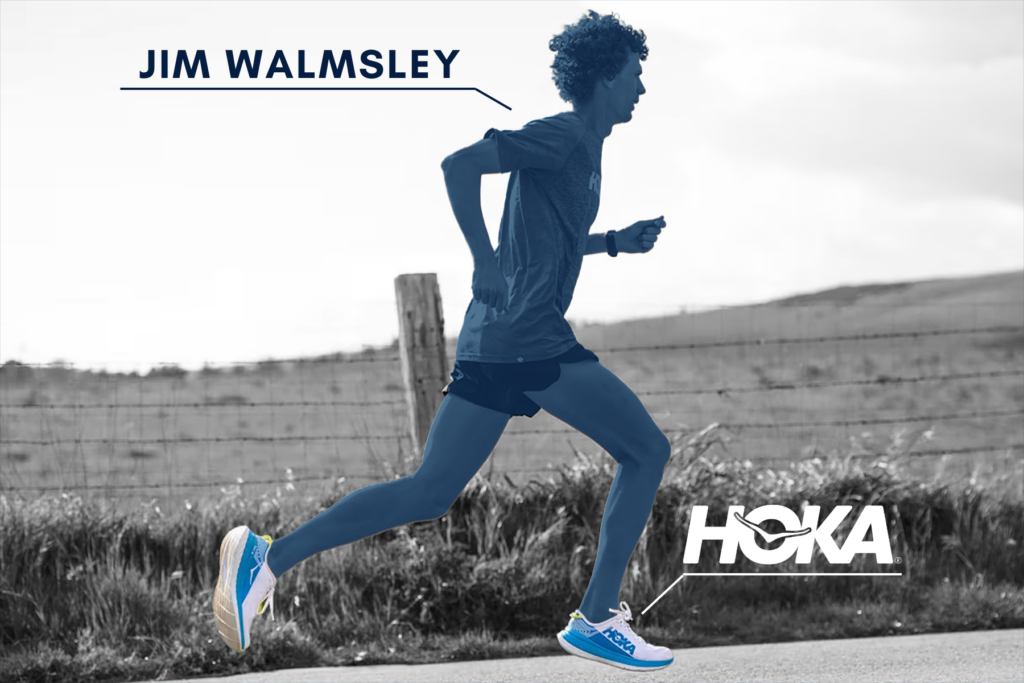
Jim Walmsley, distance and trail runner: Walmsley is a 3x winner of the Western States ultra marathon as well as a course record holder. He is also an American record holder in the 50 and 100 mile distance. His shoe of choice is the Tecton X 2.
Aliphine Tuliamuk, distance athlete: First place finisher in the 2020 Olympic Marathon Trials and 7th place at the 2022 NYC marathon, Tuliamuk is one of Hoka NAZ Elite’s most accomplished runners. Her go-to shoe is the Rocket X2, a speedy unisex carbon racer.
HOKA vs Brooks History
The History of Hoka
Two former Salomon employees, Nicolas Mermoud and Jean-Luc Diard founded Hoka in France in 2009. Their goal was to design a shoe that would help runners ‘fly downhill’—hence the name, which in the Māori language means ‘to fly.’
At the time, most running shoes were trending more minimally, so Hokas with their thick, rounded mid-soles spiked a change in the industry and influenced a trend towards more cushioned models. Hokas were initially embraced by ultramarathoners, but are now beloved by everyone from nurses to joggers to 5k runners to marathoners.
The History of Brooks
Brooks was founded in 1914 and began by making not running shoes, but bathing and ballet shoes. Over the years, they began entering into other sporting footwear such as football and baseball cleats and rollerskates.
Brooks didn’t really become a running brand until 1974, when they produced their first real running shoe, the Villanova. In 1977, the Vantage became their first running shoe to become #1 in Runner’s World. In 2001, Brooks made the change to focus only on running gear, and started creating many of its most popular models that are still around today. The brand has certainly innovated and changed quite a bit even since then. But today, Brooks is still known for its quality everyday training shoes that give the support and durability needed to get through training.
Who Are Brooks vs Hoka Best For?
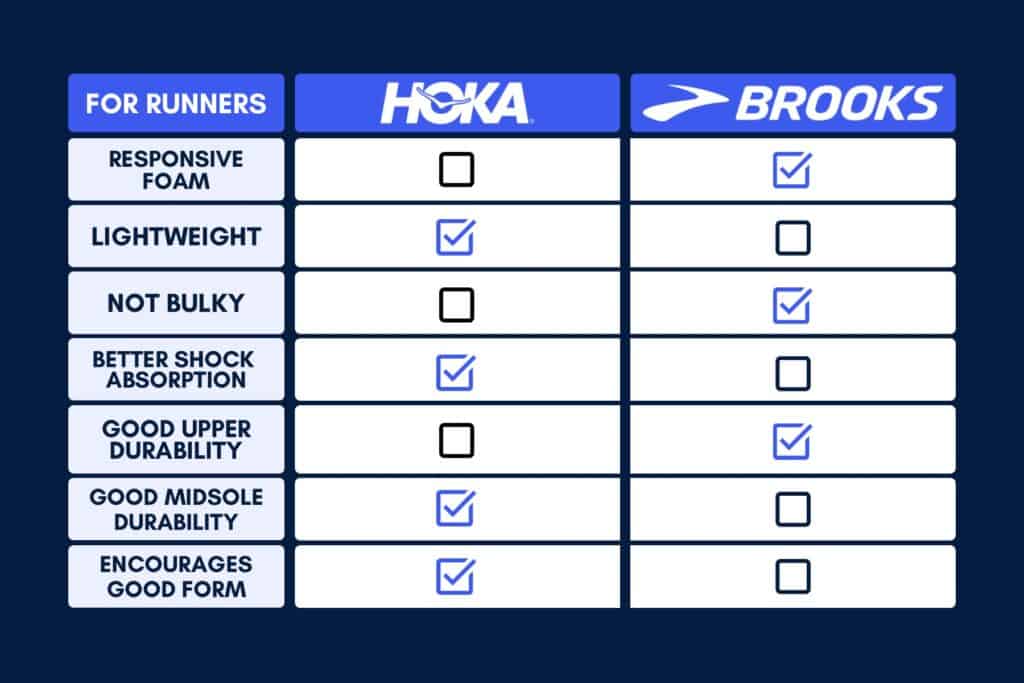
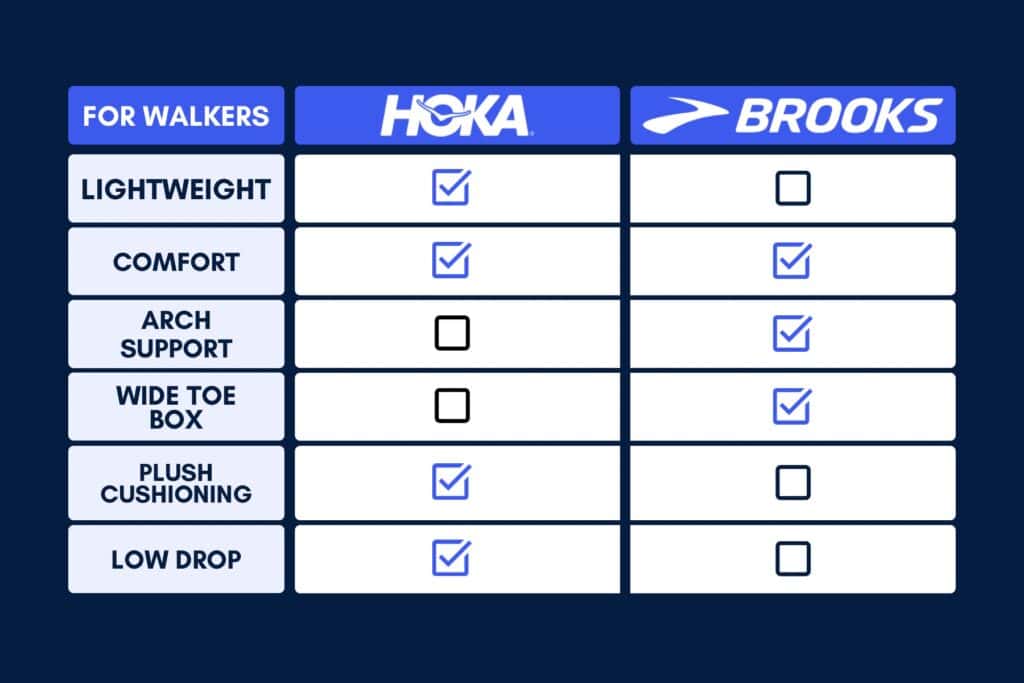
Everybody’s feet, gait, and needs are different.
But generally, Hoka shoes are best for:
- Walkers who want lightweight shoes with plush cushioning and a low drop
- Runners who want lightweight running shoes with great shock absorption and good midsole durability, all encouraging good form.
Meanwhile, Brooks shoes are best for:
- Walkers who want comfort above all else, with great arch support and possibly a wide toe box
- Runners who want a responsive, foam running shoe that doesn’t feel too bulky but is very durable
FAQs
Which Is Better: Hoka or Brooks?
Are Brooks or Hoka Better for Plantar Fasciitis?
Why Do Podiatrists Recommend Hoka?
What Shoes Are Comparable to Hokas?
Why Are Brooks Shoes Better?
–
Everything featured on Half Marathon Guide is independently selected and curated. We may receive a small commission on purchases made from some of our links.


